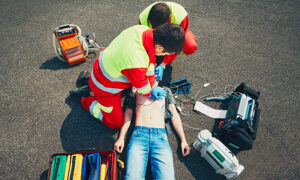There has been an ongoing debate surrounding HOA defibrillators and whether or not associations should have them. While defibrillators can save lives, they also make HOA communities vulnerable to risk and liability. Before making any decision, board members should carefully consider the variable factors that can affect their association.
HOA Defibrillators: Why Some Communities Want Them
According to the American Heart Association, more than 356,000 cardiac arrests occur out of the hospital every year in the United States. Of that number, 90% end up being fatal. Death can occur within minutes with sudden cardiac arrests. And every minute that goes by without defibrillation reduces the chances of survival. After 10 minutes, the victim only has a 1% chance of survival.
Automated external defibrillators (AEDs) play a critical role in sudden cardiac arrests. Studies have found that survival rates can increase by as much as 70% if an AED is administered within two minutes.
Hospitals are not always within reach, though. Cardiac arrests can happen anytime, anywhere—even in HOA communities. This has led some homeowners and board members to consider installing AEDs in common areas. Residents of HOAs believe it is a good idea to have defibrillators on hand in emergencies, especially in communities with aging populations.
However, it is not all black and white. HOA defibrillators might save lives but also make associations vulnerable to potential liability.
Should AEDs Be Installed in Association Communities?
Homeowners associations have no statutory requirement to install or have HOA defibrillators. Most experts even advise against it due to the risks an HOA may inadvertently take on. Unless a state law protects the HOA from liability arising from AEDs, the consensus is that it is best not to have them around. However, even with such a law, things can quickly go awry because there tend to be a lot of gray areas.
What is the Liability of an HOA If It Has a Defibrillator?
 When an HOA has a defibrillator, it can create liability if the victim of a sudden cardiac arrest suffers from brain damage or even death as a result of its use. The victim’s family could claim the association was negligent.
When an HOA has a defibrillator, it can create liability if the victim of a sudden cardiac arrest suffers from brain damage or even death as a result of its use. The victim’s family could claim the association was negligent.
Lawyers could argue that the association essentially left the plaintiff with no choice but to depend on the HOA’s employees to save a life. They could claim that the employees did not respond quickly enough to call for help or failed to use the defibrillator properly. They can even argue that the HOA failed to maintain the AED, resulting in a malfunction.
And then there is the potential for misuse. An irresponsible resident could use the AED “for fun” or “as an experiment” on others. The defibrillator can even go missing, and the association would be on the hook for it financially and if the stolen item ends up in the wrong hands.
There are countless possibilities wherein the HOA might find itself in hot water. As such, the case against HOA defibrillators is quite strong. It explains why lawyers generally advise communities not to have one.
State Laws on HOA and Defibrillators
While the potential liability is clear, it is important to check state laws for possible protections. Some states, such as Florida and California, protect individuals who use defibrillators.
In Florida, a law protects individuals who use or attempt to use a defibrillator on a person undergoing a medical emergency if the victim has no objection (Section 768.1325). The law even extends to community associations and explicitly names such organizations. However, the law also requires associations to maintain and test AEDs properly.
California has a similar law protecting individuals (Civil Code Section 1714.21). However, unlike in Florida, this law does not apply to homeowners associations. Organizations may have immunity, though, if they comply with Section 1797.196 of the Health & Safety Code. It is worth noting that organizations must strictly adhere to the requirements under this section.
Many states don’t have any such laws protecting associations from liability arising from AEDs.
Key Considerations for AEDs in HOA Communities
California’s Health & Safety Code has specific requirements for associations that have defibrillators. Although not all states have these requirements, other HOAs should also follow them to protect themselves from liability (if they choose to install AEDs).
An HOA in California with AEDs should:
- Comply with all the provisions and regulations concerning the placement of a defibrillator
- Notify an agent of the local EMS agency of the defibrillator’s type, location, and existence
- Maintain and test the AED according to the manufacturer’s guidelines
- Test the defibrillator at least bi-annually and after every use
- Inspect all AEDs every 90 days for possible issues related to the functionality of the device (including a blinking light or other clear defects that may indicate tampering)
- Follow the requirements related to keeping and taking maintenance and testing records
Building owners must also:
- At least once a year, let tenants know of the location of the AEDs and who they can contact if they wish to train in the use of AEDs or CPR administration
- At least once a year, provide a demonstration of how to use the AED to at least one person related to the building
- Post instructions on how to use the defibrillator next to the device, in a font type no less than 14 point
In addition to potential liability, an HOA’s failure to comply with all the guidelines could result in monetary fines.
An Alternative for HOA Defibrillators
 The risks outweigh the benefits of installing a defibrillator in HOA communities. However, that does not mean associations should not take the safety of residents seriously. Instead of implementing AEDs, an HOA can post signs with instructions on administering proper CPR in places it deems necessary, such as the pool area.
The risks outweigh the benefits of installing a defibrillator in HOA communities. However, that does not mean associations should not take the safety of residents seriously. Instead of implementing AEDs, an HOA can post signs with instructions on administering proper CPR in places it deems necessary, such as the pool area.
If an association insists on installing AEDs, it should take measured steps to ensure its protection from liability. It is also wise to enact a policy stating that only trained individuals can use the device, along with a sign next to the AED outlining this policy.
The General Consensus
Board members may feel tempted to install HOA defibrillators for resident safety. However, the associated risks and potential liability that follow this decision can harm an HOA. Therefore, most experts agree that it is best not to implement AEDs within HOA communities.
Navigating the ins and outs of legal compliance and liability can be challenging. Let Cedar Management Group help. Call us today at (877) 252-3327 or contact us online to learn more about our services!
RELATED ARTICLES:
- Will Your Community Benefit From Hiring HOA Lawyers?
- Is Renting Out HOA Amenities A Good Idea?
- 5 Tips For HOA Fire Safety In Your Neighborhood






